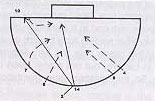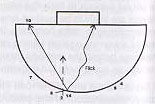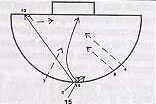A Fire In Me
I had not outlet for these questions since no coach I knew engaged us in such discussions. They viewed them as questioning their abilities, and at times even their authority!
Triumph and Trauma of a Coach
M. K. Kaushik with K. Arumugam
| Page 1 | Page 2 | Page 3 |
|
Page 4 | Page 5 | Page 6 |
A Fire In Me | I used to wonder why we could not
play to even 80% of our potential in match situations? Why have I not improved
over my weaknesses even after undergoing six months of national camp? What is
it exactly that I have achieved in all those rigorous camps?
I had not outlet for these questions since no coach I knew engaged us in such discussions. They viewed them as questioning their abilities, and at times even their authority! |
|||||
| Page 7 | Page 8 | Page 9 | Page 10 | Page 11 | Page 12 | |
![]() uring my
playing days, I came across many renowned coaches, who were all great players in
their times. Some of them were my role models in my boyhood. They include Balbir
Singh Sr., Jhaman Lal Sharma, Gurucharan Singh Bodhi, Balkrishan Singh, Raghubir
Singh Bhola, Harmeek Singh, Gurbaksh Singh, the late R. S. Gentle and V. J.
Peter, to name a few.
uring my
playing days, I came across many renowned coaches, who were all great players in
their times. Some of them were my role models in my boyhood. They include Balbir
Singh Sr., Jhaman Lal Sharma, Gurucharan Singh Bodhi, Balkrishan Singh, Raghubir
Singh Bhola, Harmeek Singh, Gurbaksh Singh, the late R. S. Gentle and V. J.
Peter, to name a few.
I would like to point out one all-pervading lacuna in all of them. They were uniformly not conversant with the opponents' play, and because of this, a vital analytical aspect was missing in the coaching scheme. I have no hesitation in telling so. We - players and trainers - were discussing only our game all the time.
What is the use in concentrating only on those aspects in which we were already masters - dodging, feinting, dribbling? These were as much necessary to us as refrigerators to Eskimos.
During the Moscow Olympics, I was pulled out midway during the matches. Coach Balkrishan never reasoned with me or informed me what my shortcoming was. Similarly, I scored the best goal of my life in the Mumbai World Cup against Netherlands. Yet, I was pulled out, without the coach Harmeek Singh giving me any reasons. Why, I felt my coach Harbans Sareen of Kirorimal College in Mumbai interacted much more with the players than the great names I mentioned earlier.
I used to wonder why we could not play to even 80% of our potential in match situations? Why have I not improved over my weaknesses even after undergoing six months of national camp? What is it exactly that I have achieved in all those rigorous camps?
I had not outlet for these questions since no coach I knew engaged us in such healthy, frank discussions, or encouraged such an attitude among their wards. On the other hand, they erroneously viewed them as questioning their own abilities, and at times even their authority!
That was how on one fine day when I was relaxing on the roof of the Coffee Home, I thought of doing a professional course in coaching. The Coffee Home in Connaught Place, Delhi, is my favourite leisure place, a home away from home. I have had numerous sittings here, mostly with my hockey friends, sipping cups of coffee and enjoying South Indian dishes.
I went on to join the National Institute of Sports, Patiala, in 1987, and completed the course without missing a single lecture or practical session to pass out with 76.4% of marks. I then coached my own team, Tata Sports Club, for a brief period, and later was with the public sector Indian Farmers Fertiliser Cooperative Ltd. (IFFCO) for nearly an year. I was enjoying my coaching, while attending to my normal duties at the now defunct Tata Oil Mills.
I got a major breakthrough when Ganesh, then the chief coach, chose me as his deputy from 1989-1990. Together, we coached the Indian team in the Asia Cup (1989, Delhi), the World Cup (1990, Lahore) and the Indira Gandhi Memorial Gold Cup (1990, Delhi).
Ganesh, a dedicated, selfless and sincere coach, was forced to resign after the Lahore fiasco, while I continued for just one more tournament - the fourth Indira Cup - which India won.
Shortly I got a reprieve when Arnawaz Damania, the then head of the Indian Women's Hockey Federation (IWHF), appointed me as the chief coach of the Indian women's team. Between February 1991 and October 1994, I coached the senior girls in 48 internationals over 11 tournaments/test series. A bronze each in the Junior Asia Cup and the Senior Asia Cup were the highlights of that tenure.
During my association with the Indian women's team, I unearthed talents like Preetam Rani Thakran, Sandeep Kaur, Seeta Gossain and Manjinder Kaur who each led the nation at one time or the other. Other talented players during my tenure included Tingoleima Chanu, Mary Stella Tirkey, Surajlata Devi, Nidhi Khullar and Ferdina Ekka.
Everything went smoothly till I became a casualty of the factional feuds that pounded the IWHF from late 1993 onwards.
![]()
| Variation 1 | Variation 2 |
 |
 |
| #4 leaves ball for #9 to score | Stopper to #8 to pusher to goal |
| Variation 3 | Variation 4 |
 |
 |
| #2 passes to #9 who scores | Direct Hit by #2, others rebound |
| Variation 5 | Variation 6 |
 |
 |
| #8 flicks, #2 goes for rebound | Dummy run by #2, #15 flicks |
Analysing Korea's Penalty Corners in the 1998 Champions Trophy
![]()